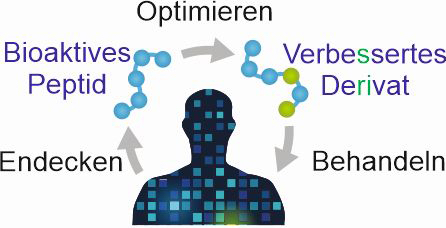Optimised peptides against infections and cancer
New bioactive ingredients from the peptidome treasure chest
Peptides are increasingly coming into scientific focus for application in diagnostics and therapy. The human body is full of these protein fragments, but only a fraction have been characterised. So there is enormous potential for discovering new biologically active substances that can help in the fight against bacteria, viruses and cancer. A collaborative research centre at Ulm University Hospital is on the trail of these promising fragments.
They are often only a few amino acids long; smaller than proteins, but quite often derived from them. The cleavage of proteins can lead to peptides that perform a variety of physiological functions in the organism. However, some also exist independently of their larger siblings, for example as messenger substances, hormones or regulators. The complete set of peptides in a body, the peptidome, is being closely examined in the second phase of a major project being undertaken by the University and University Hospital of Ulm. The project falls within the framework of the collaborative research centre, CRC 1279: "Exploiting the human peptidome for novel antimicrobial and anticancer agents".
Prof. Dr. Frank Kirchhoff, director of the Institute of Virology at Ulm University Hospital, and his colleagues have been searching for many years for bioactive molecules of interest for therapeutic developments. "It is estimated that up to 100,000 different proteins can form in the human body and be cut into small pieces by about 500 different proteases," says the virologist. "The peptidome therefore has an almost infinite complexity as far as the number of compounds that comprise it is concerned." Some of these peptides engage in interesting activities, and the 30 or so project leaders from the fields of virology, cancer research, microbiology, biochemistry, physics and pharmacology who are working with Kirchhoff are focusing in particular on compounds with the potential to improve the treatment or prevention of infectious diseases and cancer.
Attractive molecules from body fluids
 Prof. Dr. Frank Kirchhoff researches peptides and makes them even better than they already are. © Prof. Dr. Frank Kirchhoff, Ulm University Hospital.
Prof. Dr. Frank Kirchhoff researches peptides and makes them even better than they already are. © Prof. Dr. Frank Kirchhoff, Ulm University Hospital.One of CRC 1279’s goals is to develop new peptide-based methods and therapeutics that have fewer side effects than existing drugs. Since the body's own peptides are being further developed for potential therapeutic applications, the risk of side effects is reduced. Peptides play an important role in the immune response and can be recycled. Some of them show antimicrobial and antiviral activity, and unlike some antibiotics, they even have a bactericidal effect, not just a bacteriostatic one. "Apparently, the breakdown of many proteins into peptides is not entirely random," Kirchhoff says. "During immune responses, in particular, precursor molecules are cleaved to produce compounds that help us fight off pathogens." Some are known to be anti-inflammatories, while others stimulate the immune response. And scientists sometimes come across peptides that regulate the survival and spread of cancer cells.
The scientists involved in the CRC are creating peptide libraries from human body fluids. This is aimed at isolating endogenous bioactive compounds from fluids such as blood plasma, breast milk, saliva and sperm that have a benefit in certain diseases. "We want to extract the 'gold nuggets', so to speak, that most strongly inhibit a virus, a bacterium or the spread of cancer cells from the peptidome," explains the virologist.
Peptides as beacons of hope
Compared to small molecule compounds, peptides have several advantages that make them good candidates as therapeutics. They often bind more affinely and selectively to their targets and exhibit greater efficacy than small molecule compounds. The structural diversity of peptides is the result of many functional groups that can be chemically modified to further enhance their natural properties.
Another of the CRC’s goals is the optimisation of the molecules found. "Optimised peptides are usually well tolerated because they are still very similar to the body's own structures," says Kirchhoff. "In addition, they are often so small that no antibodies are produced against them." However, since much of our food also consists of proteins, many peptides are quickly proteolytically degraded in the body and excreted. The site of action is then either not reached at all, or only at low concentrations. Furthermore, peptide-based drugs cannot generally be administered orally due to their size and low stability. In addition, therapeutics often have to cross membranes in the organism, which many peptides fail to do. Several of the CRC 1279 projects are therefore aiming to stabilise endogenous peptides and transport them specifically to their site of action.
Suitable candidates can close therapy gaps
 Endogenous peptides are synthesised and optimised in the laboratory to make them effective as therapeutic agents against various diseases and are then returned to the body. © Prof. Dr. Frank Kirchhoff, Ulm University Hospital.
Endogenous peptides are synthesised and optimised in the laboratory to make them effective as therapeutic agents against various diseases and are then returned to the body. © Prof. Dr. Frank Kirchhoff, Ulm University Hospital.So-called G protein-coupled receptors (GPCRs) are an important group of membrane proteins in humans. These are often targeted by peptides and are the target of about 40 percent of all drugs. GPCRs play an important role in inflammatory processes and are overexpressed on many cancer cells. Since many cancer therapeutics, such as those used for chemotherapy, act quite non-specifically and therefore cause severe side effects, more specific targeting of cancer cells is of particular interest. Promising individual projects in the CRC aim to develop peptide-drug combinations to selectively bind receptors that are overexpressed in tumours. This approach has huge potential both for the faster diagnosis of cancer and for cancer therapy.
The chemokine receptors CCR5 and CXCR4 are also essential co-factors in HIV infections. Kirchhoff worked with Prof. Dr. Jan Münch and other colleagues to use HI viruses to discover new ligands of these GPCRs. They discovered peptides that bind to CXCR4 or CCR5 and prevent the AIDS virus from entering the target cell. "The connection with cancer came from the receptors used by HIV to enter cells, which also play an essential role in immune responses and cancer," Kirchhoff says. The majority of all tumours are CXCR4-positive. The CXCR4 receptor is, for example, involved, in the growth and metastatic spread of tumours. CRC researchers isolated EPI-X4 (endogenous CXCR4 peptide inhibitor) from the peptide library. EPI-X4 is a natural antagonist of CXCR4. It results from the cleavage of human serum albumin and switches off the receptor. In preclinical studies, optimised EPI-X4 derivatives have shown promising effects against cancer cell proliferation and inflammatory processes. Other viruses, including the coronavirus, use similar entry mechanisms to HIV, and some peptides could potentially show broad antiviral activity against multiple types of virus.
Development of new peptide-based therapies
The body's own peptides are very attractive as bioactive substances because, when optimised synthetically, they can potentially be applied to new indications. Thirty to fifty bioactive peptide compounds have already been identified in the first phase of the CRC. In the next phase, which is about to begin, one of the aims is to biochemically characterise these peptides in detail, synthesise them and ultimately optimise them pharmacologically to make them suitable for possible therapies. For this purpose, endogenous peptides usually have to be made more stable or more available to make them interesting for therapeutic or diagnostic applications. Numerous variants of an original peptide are often produced for this purpose. "This gives you some to several hundred variants that you can test to find out which properties make the peptide better," the researcher explains.
One option to prevent degradation of the peptides by enzymes is to incorporate the more stable, mirror-inverted D amino acid variant instead of the L amino acid. Likewise, lipidation can be carried out by adding fatty acids and methylation can be used to protect the amide groups. Nanotransport systems made of silica particles are also being tested to see if one can protect the peptides and deliver them specifically to their target tissue. "In some cases, we have already successfully increased the activity of endogenous peptides by a factor of 100 to 1,000," Kirchhoff says, clearly enthusiastic about what has been achieved.